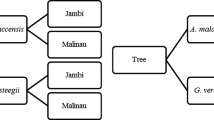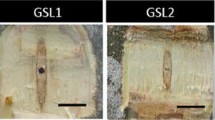Abstract
Gyrinops walla Gaertn. is the only species growing in Sri Lanka that belongs to the agarwood family, Thymelaeaceae. Although agarwood resin induction and extraction from Aquilaria species of the same family have been practised for many decades in Southeast Asian region, the ability of producing agarwood resins in G. walla was discovered recently. Since previous studies were on agarwood resins formed due to natural causes, the present study was conducted to identify the potential fungal species that are capable of artificially inducing agarwood resin formation in G. walla. Since this is the first ever study conducted on artificial inducement of agarwood resin formation in G. walla, Aspergillus niger and Fusarium solani were selected owing to their high abundance in the naturally formed agarwood resinous tissues collected from 25 G. walla trees. Both fungal species were separately grown in yeast extract glucose agar and used to inoculate healthy G. walla trees under aseptic conditions. Three holes were made for each tree and 2 g of fungal culture including the medium were placed in each hole. Tissue discoloration, characteristic aroma, resin content and resin constituents were checked at 10 cm intervals above and below the inoculation points for a period of 1 year. Results revealed that tissue discoloration and resin content were higher in the trees inoculated with A. niger. Other than at 10 cm above and below the inoculation points, samples collected at all locations had significantly higher resin contents when inoculated with A. niger compared to F. solani. Sixteen agarwood resin constituents, which were also recorded in Aquilaria species, were identified from the discolored tissues using GC–MS analysis. Jinkohol, agarospirol and 2(2-phenyl) chromone derivatives were found in all discolored tissues collected at 10-cm intervals of the trees inoculated with both fungi. β-Seline, γ-eudesmol and valerenal were found in nine of 10 sample points on the stem. γ-Elemene was recorded only in one sample. The characteristic aroma during burning was stronger for dark-colored tissues than the light-colored ones. The present study confirmed the potential use of certain fungal species to induce agarwood resin in G. walla and that A. niger is more effective than F. solani.

Similar content being viewed by others
References
Akter S, Islam MT, Zulkefell M, Khan SI (2013) Agarwood production: a multidisciplinary field to be explored in Bangladesh. Int J Pharm Life Sci 2(1):22–32
Barden A, Noorainie AN, Teresa M, Michael S (2000) Heart of the matter: Agarwood use and trade and CITES implementation for Aquilaria malaccensis. IUCN Publication, Traffic International, Cambridge
Blanchette RA (2003) Agarwood formation in Aquilaria trees: resin production in nature and how it can be induced in plantation grown trees. In: Notes from presentation at first international agarwood conference, Ho Chi Minh City, Vietnam, pp 10–15
Munsell Soil Color Charts (1994) Revised edn. Macbeth Division of Kollmorgen Instruments Corporation, New York
Chen H, Yang Y, Xue J, Wei J, Zhang Z, Chen H (2011) Comparison of compositions and antimicrobial activities of essential oils from chemically stimulated agarwood, wild agarwood and healthy Aquilaria sinensis (Lour.) Gilg trees. Molecules 16:4884–4896
Chen HQ, Wei JH, Yang JS, Zhang Z, Yang Y, Gao ZH, Sui C, Gong B (2012) Chemical constituents of agarwood originating from the endemic genus Aquilaria plants. Chem Biodivers 9(2):236–250
Chong SP, Osman MF, Bahari N, Nuri EA, Zakaria R, Abdul-Rahim K (2015) Agarwood inducement technology: a method for producing oil grade agarwood in cultivated Aquilaria malaccensis Lamk. J Agrobiotechnol 6:1–16
Cui J, Guo S, Fu S, Xiao P, Wang M (2013) Effects of inoculating fungi on agilawood formation in Aquilaria sinensis. Chin Sci Bull 58(26):3280–3287
Dassanayake MD, Fosberg FR (1981) Flora of Sri Lanka. IBH Publishing Company, New Delhi
Jensen A (2005). Domestication of Aquilaria spp. and rural poverty-socio-economic and genetic aspects of the planting boom in the wood of gods. In: Bouhom et al. (eds) Poverty reduction and shifting cultivation stabilization in the uplands of Lao PDR: technologies, approaches and methods for improving upland livelihood. National Agriculture and Forestry Research Institute, Vientiane, pp 233–239
Karlinasari L, Indahsuary N, Kusumo HT, Santoso E, Turjaman M, Nandika D (2015) Sonic and ultrasonic waves in agarwood trees (Aquilaria microcarpa) inoculated with Fusarium solani. J Trop For Sci 27(3):351–356
Laurence WVA (2013) Isolation and characterization of endophytes isolated from Akar Gaharu. Research Dissertation, Universiti Malaysia Sarawak, Malaysia
Mei W, Yang D, Wang H, Yang J, Zeng Y, Guo Z, Dong W, Li W, Dai H (2013) Characterization and determination of 2-(2-phenylethyl) chromones in agarwood by GC–MS. Molecules 18(10):12324–12345
Mohamed R, Jong PL, Zali MS (2010) Fungal diversity in wounded stems of Aquilaria malaccensis. Fungal Divers 43:67–74
Mohamed R, Jong PL, Kamziah AK (2014) Fungal inoculation induces agarwood in young Aquilaria malaccensis trees in the nursery. J For Res 25(1):201–204
Ng LT, Chang YS, Kadir AA (1997) A review on agar (gaharu) producing Aquilaria species. J Trop For Prod 2:272–285
Nor Azah MA, Chang YS, Mailina J, Abu Said A, Abdul Majid J, Saidatul Husni S, Nor Hasnida H, Nik Yasmin Y (2008) Comparison of chemical profiles of selected gaharu oils from Peninsular Malaysia. Malays J Anal Sci 12(2):338–340
Okudera Y, Ito M (2009) Production of agarwood fragrant constituents in Aquilaria calli. Plant Biotechnol 26(3):307–315
Persoon GA (2007) Agarwood: the life of a wounded tree. IIAS Newsl 45:24–25
Subasinghe SMCUP, Hettiarachchi DS (2013) Agarwood resin production and resin quality of Gyrinops walla Gaertn. Int J Agric Sci 3(1):357–362
Subasinghe SMCUP, Hettiarachchi DS (2015) Characterization of agarwood type resin of Gyrinops walla Gaertn growing in selected populations in Sri Lanka. Ind Crops Prod 69:76–79
Subasinghe SMCUP, Hettiarachchi DS, Rathnamalala E (2012) Agarwood-type resin from Gyrinops walla Gaertn: a new discovery. J Trop For Environ 2(2):44–49
Tabata Y, Widjaja E, Mulyaningsih T, Parman I, Wiriadinata H, Mandang YI, Itoh T (2003) Structural survey and artificial induction of aloes wood. Bull Wood Res Inst Kyoto 90:11–12
Tamuli P, Boruah P, Nath SC, Leclercq P (2005) Essential oil of eaglewood tree: a product of pathogenesis. J Essent Oil Res 17(6):601–604
Tian JJ, Gao XX, Zhang WM, Wang L, Qu LH (2013) Molecular identification of endophytic fungi from Aquilaria sinensis and artificial agarwood induced by pinholes-infusion technique. Afr J Biotech 12(21):3115–3131
Wetwitayaklung P, Thavanapong N, Charoenteeraboon J (2009) Chemical constituents and antimicrobial activity of essential oil and extracts of heartwood of Aquilaria crassna obtained from water distillation and supercritical fluid carbon dioxide extraction. Silpakorn Univ Sci Technol J 3(1):25–33
Zhang XL, Liu YY, Wei JH, Yang Y, Zhang Z, Huang JQ, Chen HQ, Liu YJ (2012) Production of high-quality agarwood in Aquilaria sinensis trees via whole-tree agarwood-induction technology. Chin Chem Lett 23:727–730
Author information
Authors and Affiliations
Corresponding author
Additional information
Project funding: This work was financially supported by the University of Sri Jayewardenepura, Sri Lanka and Sadaharitha Plantations Limited, Sri Lanka.
The online version is available at http://www.springerlink.com
Corresponding editor: Yu Lei.
Rights and permissions
About this article
Cite this article
Subasinghe, S.M.C.U.P., Hitihamu, H.I.D. & Fernando, K.M.E.P. Use of two fungal species to induce agarwood resin formation in Gyrinops walla. J. For. Res. 30, 721–726 (2019). https://doi.org/10.1007/s11676-018-0654-1
Received:
Accepted:
Published:
Issue Date:
DOI: https://doi.org/10.1007/s11676-018-0654-1




